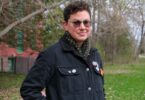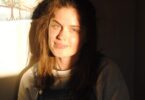The first time I heard of k.d. lang, I was twenty years old, living at home for the summer, and buckled into the back seat of the family car as we motored up the highway on the first family road trip in years. We were heading northeast towards the interior of B.C. for my cousin’s wedding. My dad had the car radio dialed to CBC where the announcer was talking about the cultural impact of someone named k.d. lang. From the front passenger seat, my mom made a knowing sound and murmured something I didn’t quite catch.
“Who is that?” I asked.
“k.d. lang,” my mom replied. A pause, and then I think she followed up with something like, “She’s a singer who used to dress like a man back in the 80s.”
The CBC announcer continued to drone on at low volume for a few more seconds before my dad reached over and pushed the OFF button, putting an end to that conversation. As we continued along the highway in silence, my mind veered into its own thoughts. Who was this Kay-dee, and how come I had never heard of her or her music? Most of all, what did it mean that she used to dress like a man? I wanted to ask my dad to turn on the radio again, but never would have dared. It would have been too suspicious for me to show interest in a woman like that. No one in the car—not my mom, dad, sister, or brother-in-law—knew the things I knew about myself. Or at least, no one admitted to it.
In the trunk of the car was our luggage: socks and underwear for several days, toiletry bags, and formal clothes for the wedding. Several weeks before, in the company of my mom, we had gone to the local Winners where I picked out a dress. This was the part of the wedding I was dreading the most: picking out a suitable outfit, putting it on my body, and wearing it to the event. It all felt like dress-up in an ill-fitting costume. I ended up going with one of the plainer options on the rack: a sleeveless A-line in mottled purple, pink, and blue. It fit nice and loose in all the right places, and its other redeeming feature was that it had pockets. But unfortunately, I would still have to bring a purse for my EpiPen unless I could get my mom to stow it in hers. I also bought a sun hat, since the wedding would be outdoors. It was a wide-brimmed cross between beach-babe and cowboy. Nothing about the hat made sense to me besides the fact that it would shield me from the sun, but I still hoped that maybe through repeated exposure I would learn to feel comfortable in these odd vestments. It’s funny how even at twenty, dressing myself felt like drag.
Even after I heard k.d.’s name for the first time, I think it took me a while to find her music. I imagine myself back at home once again using my laptop to type something like “Katie” or “Kay-dee Lang” into the search bar. Then Google probably corrected my phonetic error, and just like that I found her at last.
Two years later, back in the small community where I grew up, I enrolled in the local college and embarked on an art diploma. Over the following months I spent many evenings closed up in my bedroom kneeling on the floor while I painted, and inked, and drew. And while I did, I listened to Sam Smith confess their unrequited love, or Leonard Cohen tell me about the wild-hearted “Suzanne,” and yes, I listened to k.d. lang on repeat.
Things I learned from listening to k.d. lang:
k.d. lang is “Miss Chatelaine.”
k.d. lang is “So in Love” with “A Case of You.”
k.d. lang is not opposed to having a “Summerfling” under the “Supermoon.”
Nor is she opposed to the “Season of Hollow Soul.”
Sometimes k.d. lang is “Helpless” and “Down to My Last Cigarette.”
But through it all, k.d. lang has a “Constant Craving.” (Same here.)
Oh, and k.d. lang has “Sexuality.”
The art school that I went to was a small one, and I managed to find and befriend as many of the openly queer people as I could identify. We were a small handful, but seeing them next to me in the woodshop or across the studio at their easels made me feel alive. At the time, I had recently completed residential treatment for my eating disorder of nine years, and for the first time in my life I was flirting with what it meant to want something. Like to want to go to art school, and then to act on that desire. So in the studio while I made plaster casts of ears and navels, or screen printed mandorlas that I re-jigged as shrines to women and love, and made all sorts of other cliché objects, I was able to begin the long process of unpacking my traumas.
Living at home, the secret of my sexuality followed me around, and I was sure that my parents could see it plastered on my forehead like an indelible mark. I started to have dreams that my mother had confronted me with suspicions. Yet when I invited a college friend over my mom still asked if he and I were dating (which leads me to believe that she and my dad did not pick up on the fact that he was gay and I was currently pining after women). So on the Thanksgiving of my first year in art school I came out to my family. They were sitting around the dining room table playing cribbage, and I was just getting in (slightly disheveled) from an overnight visit with a “friend.” I had to tell them now or they would find out on their own sooner or later. I told them. And then there was silence at the table for several beats.
The Thanksgiving after that I went back to the same Winners where years before I had bought the A-line dress for the wedding and this time I purchased a set of men’s hair clippers. I had always fantasized about cutting my hair short. When I was a child and couldn’t sleep at night, I used to soothe myself by imagining scenarios where I had my hair cut short like a boy’s. Usually in my dreams someone made me cut it which absolved me of any fault or taboo of transgressing gender. But to act on that fantasy was something I never actually did. I always found some reason to stop myself: I was ashamed of showing the birthmark on my forehead, or of accentuating my chubby cheeks.
I had to go halfway around the world to realize that if I wanted to cut my hair short, maybe one day, I could work up the courage to do so. The summer between my first and second year of art school, I decided I would travel to Europe. Of the minimal music I had with me, you can bet k.d. lang’s songs accompanied me on the long plane trips and train rides. In Sweden, where I volunteered at my first Pride festival, I met another volunteer who told me he was trans. As we were chatting, I confessed that I desperately wanted to cut my hair short, but that I never could because of my chubby cheeks. I expected him to nod in agreement and offer some conciliatory remark (“But you look great with that bob,”) or to deny what I said all together (“Your cheeks? They aren’t that chubby!”). After all, those are the sort of things I was used to people saying. But instead, his reply surprised me.
“Ok, so you have chubby cheeks,” he said. “So what?! Cut your hair anyways.”
And back in Canada, with my newly purchased clippers, that is exactly what I intended to do. First I should give myself a fade, I thought. Then one day, when I’m bored of that look I’ll shave my head. But don’t shave your head first, because then you’ll have to wait for it to all grow back before you can try any other cuts. So on Thanksgiving Monday I locked myself in the downstairs bathroom, pressed play on my k.d. lang playlist, and chopped my pony tail into the sink. (To be clear, as a burgeoning art student I kept the hair in a mason jar lest I need it for an upcoming art project. It might make a nice sculpture or handmade brush, I mused.)
And as k.d. lang belted out “Constant Craving,” I hacked my way through a d.i.y. fade. The instructions that came with the clippers said to start with the longest guard, and gradually work your way down to a closer cut until you were happy with the results. After I was satisfied, I removed the guard and set the clippers down by the sink. Looking down at the instructions, I saw the final step was to use a medium length guard to blend the longer and shorter areas of hair together. I was lost in the music and the moment as I picked up the clippers, flipped the switch and brought them to the upper right side of my head.
Suddenly things were not going as planned. A patch of pale scalp showed through now where I had touched the clippers to my head. In my excitement, I had forgotten to replace the guard and had shaved a patch of my hair clean down to the scalp.
I stared at myself for a moment in the mirror wondering, “What am I going to do?” before I broke out in a flushed sweat. I tried at first to give myself an undercut, but the bare patch was too far up the side of my head for that hack to result in anything but a noncommittal mohawk. So in the end, I pushed all the guards aside, and did what I knew I would eventually do one day. I shaved it all off.
That was in 2018, and since then I’ve been on a gradual journey to relocate myself after the traumas of earlier years. I called this process “razing the raising” because I have been willing to cut down just about anything in my life to examine its core before letting it grow back. How was I taught to eat? Dress? Speak? How was I taught to be in relationships? To be a person of a particular gender? To hold space? While finding myself is gradual and internal, from the outside the steps I have taken may have appeared blatantly drastic. My mom tells me it was traumatic for her to see me change. That it was a great trauma for her. I try to ignore the way those comments pull me back to childhood, and instead make an effort to focus on growing upward and out.
It was around the time of my at-home haircut, during my two years of art school, that I mentioned k.d. lang to my mom. We were in the kitchen, me preparing a snack to bring with me to night class, and her sitting at the counter watching and keeping me company. I brought up the time back in the car, when she had told me k.d. was a woman who dressed like a man, and I asked her if she remembered that. I guess I used the word “gay” to refer to k.d., and so I was surprised when my mom reacted with silent confusion.
Me: “What…? What is it?”
Mom: “What do you mean, ‘gay’?”
“k.d. lang is gay.”
“I thought she was a lesbian.”
At the time, I couldn’t believe what I was hearing. “Mom, those are the same thing.”
I tried to explain that both words could be used to describe a non-man who has romantic or sexual feelings for other non-men.
Later she was sitting on the living room sofa reading (quite likely her Bible) as I passed her on my way out the door.
“Hey Mom…you know you can ask me, if you have questions about those kinds of things. Like about LGBTQ stuff,” I said. “I’m happy to tell you. I would actually like to tell you so you can understand more.”
“Thanks sweetie,” she said, in a way that sounded disappointingly non-committal.
I pushed back. “I just can’t believe you didn’t know a woman could be gay. I’m gay.”
“I guess I don’t know a lot about that stuff because I’m just not interested in it.” That’s what I remember her saying.
But “that stuff” is me.
I left the house and started walking toward the college. It was a clear winter evening.
“See me!” I wanted to shout. “See me! Hear me!” But of course I didn’t. She wouldn’t have heard me anyways.
Silence all around me.
In the family car and at the Thanksgiving table, there is silence.
It is everywhere in our house;
has always been.
But despite all that, I hope one day I will come to a point where I realize that, like k.d., I have learned how to use my voice. After all the silence I can make my own refrains.
Author’s note: In the years since these events took place, my family and I have been building towards more dialogue about gender and identity.
…
Meesh QX (they/them) is an interdisciplinary artist whose work spans visual art, performance, writing, film, and animation. Across these varied mediums a uniting theme in Meesh’s work is an exploration of identity including aspects of gender, race, and intergenerational ties.






